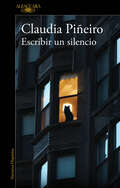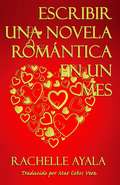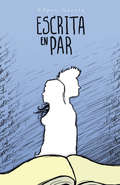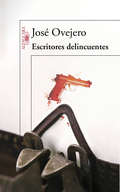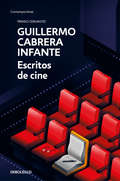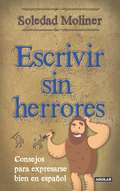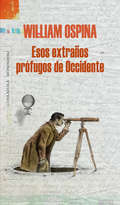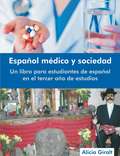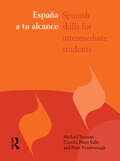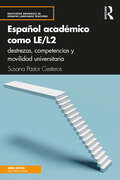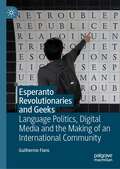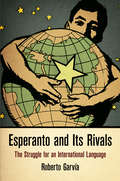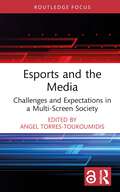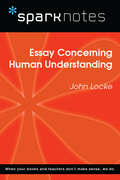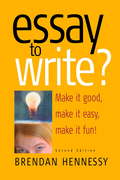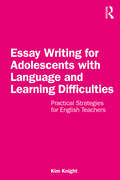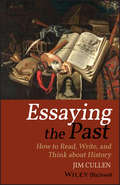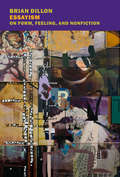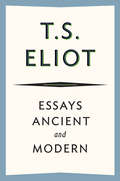- Table View
- List View
Escribir un silencio
by Claudia PiñeiroLos textos de no ficción de Claudia Piñeiro reunidos por primera vez en libro. «Sospecho que lo que escribo nace del silencio. Porque así fue desde mi niñez, del silencio a la escritura. De la resistencia a hablar, al placer de construir un texto». Admirada por miles de lectores en todo el mundo, Claudia Piñeiro es, además de una prolífica y premiada escritora de ficciones (novelas, cuentos, guiones de series y de películas, obras de teatro), una delicada observadora de la realidad. Este libro reúne por primera vez los numerosos textos publicados a lo largo de los años en distintos medios: escritos personales y autobiográficos que hablan de la infancia, la familia, las amigas, los maestros, la maternidad, así como aquellas intervenciones más políticas, como el ya célebre discurso en la Cámara de Diputados a favor de la Ley de Interrupción Voluntaria del Embarazo o los textos de apertura de ferias del libro como las de Buenos Aires o Rosario, reflexiones sobre la propia escritura, sobre escritores y escritoras que la marcaron, la pandemia o los viajes a festivales literarios. Escribir un silencio nos permite un acercamiento distinto, íntimo, a una de las escritoras más queridas de nuestro país, una referente en temas como el feminismo, los derechos de los escritores y la desobediencia como postura ética y vital. Un libro generoso y único en la trayectoria de nuestra autora más emblemática. La crítica dijo: «La adoro. Claudia se ha convertido en la gran referente de los derechos de las mujeres, con un compromiso y una claridad y una valentía y dedicación maravillosas».Mercedes Morán «Una historia que captura debates y puntos ciegos en torno a los femicidios, la muerte y la maternidad y […] un libro que dialoga con los feminismos pero también problematiza sus zonas difusas».Julieta Grosso , Télam sobre El tiempo de las moscas «La novela negra del año [...] Lo tiene todo. Apuesta literaria, crítica social, grandes temas».Juan Carlos Galindo , Babelia - El País sobre Catedrales «Breve y elegante [...] una lacerante crónica sobre la relación madre e hija, la humillación de la burocracia, la responsabilidad en el cuidado de los otros y las imposiciones del dogma religioso en las mujeres».The New York Times sobre Elena sabe «Sus libros suelen proporcionarnos muy fecundos cruces entre niveles narrativos diferentes: en Las maldiciones está la ficción política pero también un nivel absolutamente íntimo que tiene que ver con la paternidad».Eduardo Sacheri «Las viudas de los jueves es una novela ágil y un análisis implacable de un microcosmos social en acelerado proceso de decadencia».José Saramago
Escribir una novela romántica en 1 mes
by Rachelle Ayala¿Te gustaría saber cómo… … descifrar la clave del éxito de una novela romántica contemporánea de una sola trama argumental? … tener la motivación necesaria para escribir y concluir las ideas para tu historia de amor? … es posible que los autores de éxito escriban sistemáticamente y publiquen obras de alta calidad a intervalos regulares? … utilizar personajes fuertes y simpáticos y dar con buenos guiones para crear una historia de amor única? … puede un grupo de apoyo de escritoras motivarse mutuamente para escribir más rápido y mejor? … y por qué fijar un objetivo diario de conteo de palabras no es la mejor manera de monitorear tu progreso? … mantener viva tu motivación, libro tras libro, y publicar con regularidad? … hacer amigos de escritura y formar tu propio grupo de escritoras de novela romántica para alcanzar retos asombrosos? En este libro encontrarás un sencillo método para escribir una novela romántica en un corto plazo de tiempo. También descubrirás por qué escribir con el apoyo de un grupo de autoras afines es una manera increíble de aumentar tu productividad además de subirte la moral, sin olvidar que te ayudará a lo largo de tu recorrido tanto en el proceso de escribir como de publicar. Gran parte empieza dentro de ti, tus creencias, deseos y la fe que tengas en ti misma. Sin embargo, si a eso añades técnicas probadas y la utilización de procedimientos que funcionan, podrás llevar tu escritura al siguiente nivel, terminar tus historias a un ritmo más rápido y que eso se convierta en tu rutina. Escribir una novela romántica en 1 mes es un método sencillo para escribir una historia romántica con la ayuda de una comunidad de escritoras. Nuestro objetivo es hacer posible que acabes una novela de una sola trama al cabo de un mes de trabajo y darte las técnicas necesarias para conseguirlo.
Escrita en par
by Edpro GarcíaUna novela juvenil, de cómo se pueden explorar los más profundos sentimientos de la persona que amas, a través de lo que escribe. <P><P>¿Qué harías si tuvieras la oportunidad de conocer los más reales y profundos pensamientos de la persona que amas? <P>Adrián y Nelly deciden escribir un libro juntos, una historia compartida, su año de noviazgo resumido en un libro con ambos puntos de vista y para ello solo existen dos reglas: <br>1) No mostrar nada de su parte del libro hasta terminarlo. <br> 2) Ser completamente sinceros. <P>Se dice que en toda relación siempre existe alguien que ama más. Descubre el secreto que guardan las palabras de cada uno de los personajes de esta historia escrita en par.
Escritores delincuentes
by José OvejeroUna truculenta historia de la literatura de la mano de la criminalidad. «Quien es capaz de escribir un gran libro no se merece estar entre rejas. Eso debieron de opinar Cocteau y Sartre cuando defendieron a Genet, y tantos otros intelectuales que, a veces sin conocer bien los hechos delictivos de sus protegidos, se lanzaron a una cruzada para liberarlos. No me considero inmune a la fascinación por los fuera de la ley. ¿Burroughs mató a su mujer jugando a Guillermo Tell? ¿Álvaro Mutis estuvo en la famosa cárcel de Lecumberri por malversación? ¿Anne Perry fue una adolescente asesina? Quizá, al principio me empujaba sobre todo una curiosidad algo morbosa. Pero los escritores seleccionados no son interesantes sólo por su biografía. Lo verdaderamente interesante es la relación entre ésta y su obra, cómo en ambas se entrelazan temas como la culpa, las injusticias sociales, la capacidad redentora -o no- de la escritura, la verdad en la ficción, la mentira en la autobiografía, la relación con la propia violencia, su mirada sobre la cárcel, sobre los jueces, sobre otros delincuentes, la impresionante tensión entre lo que dicen y lo que callan... El libro del escritor delincuente se vuelve una nueva sala del tribunal, y el lector el jurado o, en algún caso, un nuevo acusado como miembro de esa sociedad a la que condena el delincuente. En pocas ocasiones une la literatura de forma tan consciente a escritor y lector, no sólo mediante el acto literario, también a través de la confrontación entre sus valores y opiniones.» JOSÉ OVEJERO
Escritos de cine (estuche: Un oficio del siglo xx, Arcadia todas las noches, Cine o Sardina)
by Guillermo Cabrera InfanteLas tres colecciones de artículos sobre cine de Guillermo Cabrera Infante en un estuche que se disfruta como una función. Director de la cinemateca de Cuba y crítico de cine en su juventud, guionista de Hollywood en su madurez, Guillermo Cabrera Infante fue un apasionado cinéfilo toda su vida. El presente estuche reúne sus tres colecciones de ensayos sobre el tema: Un oficio del siglo xx, Arcadia todas las noches y Cine o sardina. En ellas brillan su espíritu lúdico y la fina ironía, que nos ayudan a comprender el sentido, el contexto y la factura del séptimo arte. De texto en texto y de mirada en mirada, Cabrera Infante repasa la obra de Orson Welles, Alfred Hitchcock, Howard Hawks, John Huston o Vincente Minnelli, así como una plétora de películas clásicas y modernas. Si el cine es el protagonista indiscutible, el crítico-escritor no deja de darle la réplica. Del diálogo entre la pantalla y la palabra surgen textos que no solo aportan una valiosa información, sino que se disfrutan como verdaderas funciones. Sobre el autor y la obra:«Para los que estudiábamos cine, Un oficio del siglo XX era un libro de cabecera.»Fernando Trueba «Ha convertido la crítica cinematográfica en un género literario gracias a su riqueza verbal y a su imaginación.»Mario Vargas Llosa «Cabrera Infante es casi una enciclopedia del cine hollywoodense.»Jacobo Machover, Revista de Libros
Escritos de un sonámbulo
by Antón PatiñoUn viaje, en clave de ensayo singular, a través de las palabras y los autores que marcan la ruta de nuestro tiempo. Aviso de lectura No se me quejen: en este libro, que tiene el aire de un ensayo pero en realidad es un viaje por las palabras, las ideas y los autores que configuran el mapa de nuestra contemporaneidad, ustedes podrán reflexionar y charlar en compañía de Georges Bataille, Samuel Beckett, Maurice Blanchot, Nietzsche, Mallarmé, Baltasar Gracián, Antonio Machado, Georgia O#Keeffe, Pessoa, Luis Pimentel, Marcel Duchamp, Edgar Morin, Kostas Axelos, Jorge Barbi, Winnicott, Roger Caillois, Jean-François Lyotard, Julia Kristeva, Bernard Pingaud, Octavio Paz, Uxío Novoneyra, Lezama Lima, Richard Serra, Guy Debord, Perry Anderson, Eduardo Subirats, Elias Canetti, Baudrillard, Régis Debray, Adorno, Henri Michaux, Mark Tobey, Giorgio de Chirico, Heidegger, Severo Sarduy, Horkheimer, Kafka, Goethe, Walter Benjamin, Giorgio Colli, Ernest Jünger, Miguel Morey, Artaud, Deleuze, Proust, Erich Kahler, Eduardo Chillida, Calder, Luis Fernández, James Joyce, Maruja Mallo, Luis Gordillo, María Zambrano, Rimbaud, Henri Foncillon, Francis Ponge, Constantin Brancusi, Arundhati Roy, Javier Couso, Che Guevara, André Malraux, Urbano Lugrís, Hanna Arendt, Martín López Guerra, Baudelaire, Paul Klee, Hegel, Kant, Lukács, Carl Einstein, Picasso, Joan Miró, Paul Éluard, Merleau-Ponty, Claude Lévi-Straus, Susan Sontag, Rothko, Gao Xingjian, José Ángel Valente, Tàpies, Guattari, Basquiat, Keith Haring, Buñuel, René Char, Buck-Morss, Celan, Francisco Jarauta, Juan Eduardo Cirlot, Bill Viola, Bob Wilson, Wilhelm Reich, Michel de Certeau, Warburg y Karl Kraus, entre otros. También está Buenaventura Durruti, pero no aparecen ni Ken Follett ni Mario Vargas Llosa. Dime con quién andas y te diré quién eres.
Escrivir sin herrores: Consejos para expresarse bien en español
by Soledad MolinerPor primera vez en un solo tomo reunidas las obras máximas sobre el castellano de SOLEDAD MOLINER: Primeros auxilios para hablar bien el español, caja de citas y Pida la palabra. Una obra imprescindible para aprender a hablar sin errores. ¿Quiénes chatean? Chatean los que mantienen conversaciones escritas a través de ciertos medios informáticos. ¿Cuándo empezaron a chatear los que chatean? Según documentos acreditados, en 1639. ¿Cómo pudieron chatear los que chateaban hace casi cuatro siglos, si los medios informáticos son un invento reciente? Las respuestas* a estas y a muchas otras preguntas relacionadas con la lengua española, su historia, su constante avance, sus reglas y sus errores aparecen en este libro. Se reúnen en él dos éxitos anteriores de esta deliciosa autora -Pida la palabra y Primeros auxilios para hablar bien español-, previo un cuidadoso trabajo de actualización al ritmo en que la lengua evoluciona y cambia. *Chatear significó beber vino en vaso chato (más ancho que alto). Los tataranietos de quienes así usaban el verbo decidieron emplearlo para las conversaciones por chat. Por eso hoy chateamos# sin vino.
Esos extraños prófugos de Occidente
by William OspinaCon estos ensayos, William Ospina cuestiona a las personas, el papel queestamos llevando en el mundo y la importancia de nuestras acciones. Rimbaud abandono las letras a los diecinueve años para dedicarse alcontrabando en África, en un desesperado intento por olvidar su mundo ysu pasado. Whitman entendió que una de las maneras de alcanzar el idealdemocrático que su nación prometía era desistir de la exaltación deídolos y dioses, herencia de la tradición clásica. Emily Dickinson creyórenunciar al universo pero se quedo con el lenguaje, que contiene todaslas cosas. Lord Byron se convirtió en el mayor héroe romántico de lahistoria al dejarlo todo para luchar por la libertad de los pueblossojuzgados. Faulkner develo con su literatura las dos mayores barbariesde la Norteamérica de comienzos de siglo XX: la intolerancia y elracismo. Holderlin vio no solo el extravío de Occidente en un humanismoarrogante, sino la abyecta tendencia al saqueo, la explotación y ladestrucción del planeta.En esta prodigiosa mirada de William Ospina, el escape de una sociedadhostil y el peso de la herencia, que en ocasiones prometen y en otrasamenazan, son el impulso común de esos extraños prófugos de Occidente.
Espanol medico y sociedad: Un libro para estudiantes de espanol en el tercer ano de estudios (Revised Edition)
by Alicia GiraltEspanol medico y sociedad/ Medical Spanish and Society is an innovative textbook that fulfills the needs of upper-division Spanish students who are pursuing degrees in the health professions, plan to become medical interpreters or just want to improve their proficiency in the language. It provides multiple opportunities to learn vocabulary related to the medical field, reviews hard-to-understand grammatical concepts, describes health-related cultural competence and presents opportunities to discuss issues of concern about the health of Hispanic communities in the US and abroad.
España a tu alcance: Spanish Skills for Intermediate Students
by Peter Furnborough Concha Pérez Valle Michael TrumanEspaña a tu alcance provides intermediate students with a genuine insight into Spanish culture via a range of practical activities and exercises. The course includes many unscripted recordings of interviews with Spaniards from a variety of geographical areas. Students explore these recordings through activities designed to develop listening, speaking, reading and writing skills.This course suitable for classroom use or independent learning.
Español académico como LE/L2: destrezas, competencias y movilidad universitaria (Routledge Advances in Spanish Language Teaching)
by Susana Pastor CesterosEspañol académico como LE/L2: destrezas, competencias y movilidad universitaria ofrece una completa visión del área del español académico como LE/L2 en la educación superior. Escrito en español, este libro aborda las prácticas letradas académicas en el mundo hispánico tanto en el aula como en la investigación. Combina una orientación teórico-práctica, con pautas y herramientas para ayudar a los aprendices de español a comunicarse en contexto académico universitario. Entre las características principales del libro se incluyen: Información para cubrir las necesidades educativas de estudiantes internacionales de grado y posgrado en universidades de habla hispana. Secuenciación de contenidos para favorecer la enseñanza del lenguaje académico a estudiantes con lenguas maternas, perfiles lingüísticos y tradiciones culturales académicas diferentes. Análisis de los géneros orales y escritos académicos: interacción en el aula, presentaciones orales, comunicaciones en congresos, ensayos, reseñas, exámenes escritos, trabajos de investigación, defensas... Abundantes ejemplos, actividades y recursos en cada capítulo. Pautas curriculares para planificar cursos de español académico y otras intervenciones didácticas, en distintos contextos de aprendizaje. Perspectiva global del español académico para estudiantes no nativos, que incluye a las universidades tanto españolas como hispanoamericanas. Español académico como LE/L2 es una obra de referencia para docentes de español como L2, formadores del profesorado, estudiantes de español nativos y no nativos, así como para cualquier persona interesada en el español académico. Español académico como LE/L2: destrezas, competencias y movilidad universitaria offers a comprehensive overview of Academic Spanish as a FL/L2 in Higher Education. Written in Spanish, this book deals with academic literacy practices in the Hispanic world, both in the classroom and in research. It combines a theoretical-practical orientation, with guidelines and tools, to help Spanish learners to communicate in an academic context of higher education. Main features of this book include: • Information to fulfill the educational needs of undergraduate and graduate international mobility students in Spanish-speaking universities. • Content planning to improve the teaching of academic Spanish to students with different mother tongues, linguistic profiles and academic cultural traditions. • Analysis of oral and written academic genres: interaction in the classroom, oral presentations, papers, essays, reviews, written exams, thesis, and defenses. • Abundant examples, activities and resources in each chapter. • Curricular guidelines for planning academic Spanish courses and other didactic interventions in different learning contexts. • Global perspective of academic Spanish for non-native students, which includes both Spanish and Latin American universities. Español académico como LE/L2 is the ideal reference work for teachers, teacher trainers and students of the Spanish language, both native and non-native speakers, as well as those interested in academic Spanish.
Esperanto Revolutionaries and Geeks: Language Politics, Digital Media and the Making of an International Community
by Guilherme FiansThis book explores how Esperanto – often regarded as a future-oriented utopian project that ended up confined to the past – persists in the present. Constructed in the late nineteenth century to promote global linguistic understanding, this language was historically linked to anarchism, communism and pacifism. Yet, what political relevance does Esperanto retain in the present? What impacts have emerging communication technologies had on the dynamics of this speech community? Unpacking how Esperanto speakers are everywhere, but concentrated nowhere, the author argues that digital media have provided tools for people to (re)politicise acts of communication, produce horizontal learning spaces and, ultimately, build an international community. As Esperanto speakers question the post-political consensus about communication rights, this language becomes an ally of activism for open-source software and global social justice. This book will be of relevance to students and scholars researching political activism, language use and community-building, as well as anyone with an interest in digital media more broadly.
Esperanto and Its Rivals
by Roberto GarvíaThe problems of international communication and linguistic rights are recurring debates in the present-day age of globalization. But the debate truly began over a hundred years ago, when the increasingly interconnected world of the nineteenth century fostered a desire for the development of a global lingua franca. Many individuals and social movements competed to create an artificial language unencumbered by the political rivalries that accompanied English, German, and French. Organizations including the American Philosophical Society, the International Association of Academies, the International Peace Bureau, the Comintern, and the League of Nations intervened in the debate about the possibility of an artificial language, but of the numerous tongues created before World War II, only Esperanto survives today.Esperanto and Its Rivals sheds light on the factors that led almost all artificial languages to fail and helped English to prevail as the global tongue of the twenty-first century. Exploring the social and political contexts of the three most prominent artificial languages--Volapük, Esperanto, and Ido--Roberto Garvía examines the roles played by social movement leaders and inventors, the strategies different organizations used to lobby for each language, and other early decisions that shaped how those languages spread and evolved. Through the rise and fall of these artificial languages, Esperanto and Its Rivals reveals the intellectual dilemmas and political anxieties that troubled the globalizing world at the turn of the twentieth century.
Esperanza
by Carol GaabEsperanza by Carol Gaab is perfect for level 1 Spanish students! This hardcover book is a narrative nonfiction written in first person. This novel is based on the chilling true story of a young family caught in the middle of political corruption and unspeakable violence during Guatemala’s 36-year civil war. Tired of watching city workers endure countless human and civil rights violations, Alberto organizes a union. When he and his co-workers organize a strike, Alberto and his family find themselves on the government’s “extermination” list. The violent situation leaves Alberto separated from his family and forces them all to flee for their lives. Will their will to survive be enough to help them escape and reunite? And if so, will they ever find another place they can call home? The exceptionally low unique word count and high frequency factor (the number of times core structures are embedded in the text) in the Comprehension-based reader, ‘Esperanza’, make this an ideal read for advanced beginning Spanish students. Each page is loaded with cognates (words that are similar in English and Spanish), recycled vocabulary, and illustrations, which makes this read highly comprehensible. Enjoy the story! The more you enjoy it, the more you will acquire Spanish without even realizing it! We hope you enjoy reading your way to FLUENCY!
Esports and the Media: Challenges and Expectations in a Multi-Screen Society (Routledge Focus on Digital Media and Culture)
by Angel Torres-ToukoumidisThis book takes a multidisciplinary approach to the question of esports and their role in society. A diverse group of authors tackle the impact of esports and the ways in which it has grown within the entertainment industry around the world. Chapters offer a coherent response to the following questions: What role do esports play in the entertainment industry? What communication skills can be learned through esports? What do the media gain from broadcasting esports? What is the relationship between social networks and esports? What are the main marketing strategies used in esports? What effect does communicative globalization have on the development of esports? What is the relationship between merchandising and esports? What do communication experts think about esports? Offering clear insights into this rapidly developing area, this volume will be of great interest to scholars, students, and anyone working in game studies, new media, leisure, sport studies, communication studies, transmedia literacy, and digital culture.
Esports and the Media: Challenges and Expectations in a Multi-Screen Society (Routledge Focus on Digital Media and Culture)
by Angel Torres-ToukoumidisThis book takes a multidisciplinary approach to the question of esports and their role in society. A diverse group of authors tackle the impact of esports and the ways in which it has grown within the entertainment industry around the world.Chapters offer a coherent response to the following questions: What role do esports play in the entertainment industry? What communication skills can be learned through esports? What do the media gain from broadcasting esports? What is the relationship between social networks and esports? What are the main marketing strategies used in esports? What effect does communicative globalization have on the development of esports? What is the relationship between merchandising and esports? What do communication experts think about esports? Offering clear insights into this rapidly developing area, this volume will be of great interest to scholars, students, and anyone working in game studies, new media, leisure, sport studies, communication studies, transmedia literacy, and digital culture.The Open Access version of this book has been made available under a Creative Commons Attribution-Non Commercial-No Derivatives 4.0 license: https://www.taylorfrancis.com/books/oa-edit/10.4324/9781003273691/esports-media-angel-torres-toukoumidis
Essay Concerning Human Understanding (SparkNotes Philosophy Guide)
by SparkNotesEssay Concerning Human Understanding (SparkNotes Philosophy Guide) Making the reading experience fun! SparkNotes Philosophy Guides are one-stop guides to the great works of philosophy–masterpieces that stand at the foundations of Western thought. Inside each Philosophy Guide you&’ll find insightful overviews of great philosophical works of the Western world.
Essay To Write? 2nd Edition: Make It Good, Make It Easy, Make It Fun!
by Brendan HennessyWhether you are studying to graduate high-school or university, whatever the major, you need to get your essays right. This book will ensure that your essay flows smoothly from the introduction to that all-important conclusion.
Essay To Write? 2nd Edition: Make It Good, Make It Easy, Make It Fun! (Student Handbooks Ser.)
by Brendan HennessyWhether you are studying to graduate high-school or university, whatever the major, you need to get your essays right. This book will ensure that your essay flows smoothly from the introduction to that all-important conclusion.
Essay Writing for Adolescents with Language and Learning Difficulties: Practical Strategies for English Teachers
by Kim KnightEssay Writing for Adolescents with Language and Learning Difficulties is a step-by-step guide for educators teaching secondary students with language difficulties how to write an English essay and, more importantly, how to do this on their own. Essay writing is one of the most difficult skills that secondary school students need to develop, though there are limited resources available to support these students and their teachers. Based on research into language disorders in adolescence and language processing, the strategies in this book are easy to apply and represent a scaffolded and sequenced approach to teaching essay writing. The book's structure encourages students' skills and confidence to be developed gradually, each chapter building on the last, beginning with the early stages of text analysis and progressing through to writing a complete essay. While written with students with language difficulties in mind, the strategies in this book are applicable to teaching all secondary school students. Written by a speech pathologist with over a decade’s experience working in secondary schools, this book is an essential resource for all high school English teachers and any education professionals responsible for teaching adolescents how to write essays competently and confidently.
Essaying the Past: How to Read, Write, and Think about History
by Jim CullenPart research manual, part study guide, and part introduction to the study of history, Essaying the Past guides the reader through the nuts and bolts of producing good historical prose, offering key strategies and useful tips. Includes expert advice on writing about history, conducting good research, and learning how to think analytically Covers important topics such as framing questions, developing a strong introduction and topic sentences, choosing good evidence, and the crucial role of revision An annotated case study takes the reader through one student’s process of writing an essay and illustrates how strategies discussed in the book can be successfully implemented Six appendices cover the major issues facing students today, such as the dangers of plagiarism and the role of the internet
Essaying the Past: How to Read, Write, and Think about History
by Jim CullenLearn to craft the perfect historical research paper with this approachable and practical guide Essaying the Past: How to Read, Write, and Think about History, 4th Edition continues the tradition of excellence established by the previous editions. Equal parts research manual, study guide, and introduction to the study of history, this book teaches readers how to write excellent historical prose with approachable strategies and actionable tips. Noted teacher and writer Jim Cullen has created an invaluable resource for novices and experts in the field of historical study, offering practical insights into determining how questions should be framed, developing strong introduction and topic sentences, choosing evidence, and properly revising your work. Essaying the Past includes six appendices covering the major issues facing students today, including the pitfalls and temptations of plagiarism and the role of the internet. It also contains an annotated case study outlining one student’s process of writing an essay and demonstrating the application of the concepts contained within the book. Essaying the Past covers topics including: How to think and read about history and ask the right questions about what you’re reading The three components of crafting a compelling argument How to deal with counterarguments and counterevidence How to properly construct a bibliography and insert footnotes How to assess the credibility of online resources Perfect for students taking surveys or courses in methods or historiography, Essaying the Past also belongs on the bookshelf of anyone with even a passing interest in studying, researching, consuming, or writing about history.
Essayism: On Form, Feeling, and Nonfiction
by Brian DillonA compelling ode to the essay form and the great essaysists themselves, from Montaigne to Woolf to Sontag.Essayism is a book about essays and essayists, a study of melancholy and depression, a love letter to belle-lettrists, and an account of the indispensable lifelines of reading and writing. Brian Dillon’s style incorporates diverse features of the essay. By turns agglomerative, associative, digressive, curious, passionate, and dispassionate, his is a branching book of possibilities, seeking consolation and direction from Michel de Montaigne, Virginia Woolf, Roland Barthes, Theodor Adorno, Walter Benjamin, Georges Perec, Elizabeth Hardwick, and Susan Sontag, to name just a few of his influences. Whether he is writing on origins, aphorisms, coherence, vulnerability, anxiety, or a number of other subjects, his command of language, his erudition, and his own personal history serve not so much to illuminate or magnify the subject as to discover it anew through a kaleidoscopic alignment of attention, thought, and feeling, a dazzling and momentary suspension of disparate elements, again and again.
Essays Ancient and Modern
by T. S. EliotThe Nobel Prize–winning author shares his thoughts on literature, religion, and the classics in a series of essays.A collection of essays grappling with some of the most significant topics of our time, Essays Ancient and Modern reveals Eliot’s thoughts on his literary contemporaries and predecessors, the role of religion in a secular society, and the continuing tradition of the classics in modern education. Astute and erudite, here we see the inner thoughts of one of our greatest minds, articulated in some of his most eloquent and direct prose.
Essays Anglican and Analytic: Explorations in Critical Catholicism
by Robert MacSwainExplore the riches at the intersection of Anglican and philosophical theology. In this thought-provoking essay collection, Robert MacSwain explores important connections between Anglican and philosophical theology. Shining a spotlight on the underappreciated theological work of Austin Farrer and David Brown, he brings them into creative conversation with better-known figures such as Joseph Butler, C. S. Lewis, Stanley Hauerwas, and Eleonore Stump. He skillfully leads readers through diverse conceptual territory ranging from the Reformed epistemology of Alvin Plantinga and Nicholas Wolterstorff, to the hiddenness argument of J. L. Schellenberg, to a sacramental vision of human culture and the arts. More broadly, MacSwain outlines what he calls &“Critical Catholicism,&” explaining how it differs from other movements in contemporary Christian thought such as Radical Orthodoxy and Analytic Theology. These perceptive essays will be of particular interest to scholars and pastors who are curious about connections between theology, philosophy, and Anglican studies.
